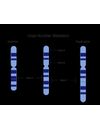

- Home
- Companies
- AccuGenomics, Inc.
- Applications
AccuGenomics, Inc. applications
SNAQ-SEQ ctDNA spike-in standards
Liquid biopsies offer the promise of earlier detection and monitoring of cancer patients’ treatment progression. However, as applications increasingly rely on ultra low variant allele frequency detection, NGS-based assays are beset with significantly more noise below 0.5% VAF that increases the rate of false positives. Laboratories looking to implement ctDNA assays need better quality controls that can ensure accurate detection and reporting by variant calling algorithms.Standardizing within patient measurements and across sites and platforms are equally critical to ensuring accurate reporting of results and harmonization of patient care.
Copy Number Variants (CNV) are a clinically important variant type to identify in both somatic and germline genomes. NGS workflows and analytics are increasingly able to resolve duplications, deletions, and other CNVs, alongside SNVs and Indels in a streamlined workflow. These detection algorithms rely on consistent coverage and reads across the genome to accurately identify copy number changes within the genome. However, GC rich regions, suboptimal capture and sequencing primers can impact resolution of CNVs and result in ‘blind spots’ and potentially missed calls.
The manufacture of biopharmaceutical agents such as therapeutic monoclonal antibodies, vaccines and cell-based therapies like CAR-T cells require the highest quality control against the contamination of adventitious agents. These pathogens can enter the manufacturing process at multiple stages and impact yield and safety. Current methods for detection of adventitious agents are expensive, lack sensitivity and have long turn around times to results. Moreover, many of the current adventitious agent testing methods rely heavily on animal-based testing to monitor for infection response.
The rapid emergence of the COVID-19 pandemic has thrust tools like next generation sequencing (NGS) applications to the forefront of the global public health response. NGS is a sensitive and specific tool that is being used to detect the presence of the SARS-CoV-2 virus from a variety of clinical and environmental samples.
Tracking SARS-CoV-2 viral strain evolution is critical for monitoring new regional outbreaks, contact tracing, infection control and verifying the performance of front-line RT-PCR diagnostic assays. Being able to report accurate sequence variations confidently, is critically important.
Measuring mRNA transcript abundance with RNASeq methods offers clinical researchers a powerful platform to examine changes in the expression levels of multiple biomarkers.
The power of targeted RNASeq lies in its ability to count the number of reads of a given transcript in a sample as a surrogate for expression level, much like a digital PCR system but able to measure 100s of biomarkers simultaneously.
A challenge to widespread adoption of RNASeq transcript abundance measurement for clinical studies and diagnostics is yield biases between targets affecting accuracy and reproducibility of the assay. Implementing a unique molecular index (UMI) approach can reduce bias, but at a cost of >8 fold increase in read depth.


